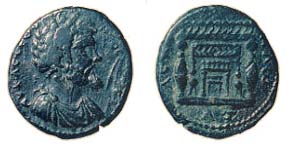Fort Knox on the Mediterranean. Ashkelon minted coins for a nearly unbroken 600-year span, from about 375 B.C. to 235 A.D.
Second- and third-century A.D. coins like this one—shown with the obverse and reverse side by side— testify not only to the city’s wealth as a seaport but also to the staying power of Phoenician culture even into the Roman period.
This coin bears the portrait of Septimius Severus, Roman emperor from 193–211 A.D. Its reverse side depicts a series of doorways leading to the inner sanctum of the temple of Phaneµbalos at Ashkelon. Phaneµbalos is the Greek transcription of paneµ Ba‘al (Face of Ba‘al), a common name for Tanit, the Phoenician goddess whose consort was the mountain god Ba‘al H|amoµn. The outer doorway shown here is flanked by columns supporting a disc and crescent (symbol of either Tanit or Ba‘al H|amoµn), with a frieze of Egyptian cobras above the lintel.

